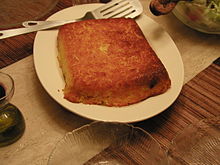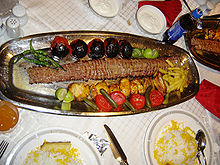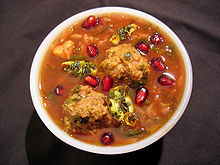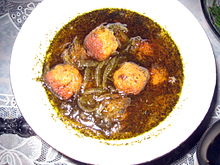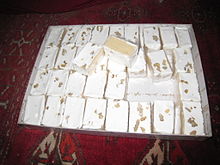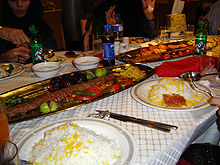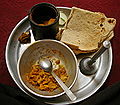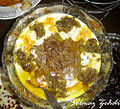- Iranian cuisine
-
Iranian cuisine is diverse, with each province featuring dishes, culinary traditions and styles distinct to its region. It includes a wide variety of foods ranging from chelo kabab (rice served with roasted meat: barg, koobideh, joojeh, shishleek, soltani, chenjeh), khoresht (stew that is served with white basmati or Iranian rice: ghormeh sabzi, gheimeh, and others), aash (a thick soup: for example Ash-e anar), kookoo (vegetable Souffle), polo (white rice alone or with addition of meat and/or vegetables and herbs, including loobia polo, albaloo polo, Sabzi polo, zereshk polo, Baghali Polo and others), and a diverse variety of salads, pastries, and drinks specific to different parts of Iran. The list of Persian recipes, appetizers and desserts is extensive.
Fresh green herbs are frequently used along with fruits such as plums, pomegranates, quince, prunes, apricots, and raisins. Typical Persian main dishes are combination of rice with meat, lamb, chicken, or fish and some onion, vegetables, nuts, and herbs. To achieve a balanced taste, characteristic Persian flavorings such as saffron, dried limes, cinnamon, and parsley are mixed delicately and used in some special dishes.
Contents
Cooking techniques
Cooking over an open fire is traditional Iranian practice. Another method is slow cooking, without exposure to flame, in a copper cauldron (dig-e messi) or a special oven (tannour) made of fire clay . Soups (ahsh), broths (ab-gousht), rice (polo, chello), stews (khoresht), pot-roasts and many sweet delicacies can be cooked in this way. The method remains in favor today with modern gas or kerosene heating appliances. The old-type cooking stove (fer) has ceased to be popular, though it remains the best means of cooking certain traditional dishes (like the vegetable omelet called Kuku). Another traditional skill, which still thrives, is the grilling of all sorts of Kababs over red-hot charcoal (Zoghal-e chub).[1]
National cuisine
Rice
It is believed that rice (berenj in Persian) was brought to Iran from the Indian subcontinent in ancient times. Varieties of rice in Iran include champa, rasmi, anbarbu, mowlai, sadri, khanjari, shekari, doodi, and others. Basmati rice from Pakistan is very similar to these Persian varieties and is also readily available in Iran. Traditionally, rice was most prevalent as a major staple item in the rice growing region of northern Iran, and the homes of the wealthy, while in the rest of the country bread was the dominant staple. The varieties of rice most valued in Persian cuisine are prized for their aroma, and grow in the north of Iran. There are three primary methods of cooking rice in Iran:
Rice cooking method Method Description Polo rice is prepared by soaking in salted water and boiled, while parboiled rice is called Chelo. Chelo is drained and put back in the pot to be steamed. This method results in an exceptionally fluffy rice with the rice grains separated and not sticky. A golden rice crust is created at the bottom of the pot called Tah-deeg (literally "bottom of the pot"). Tah-deeg can be plain or with spreading lavash or other thin breads or slices of raw potatoes on the bottom of the pot. Meat, vegetable, nuts and fruits are sometimes added in layers or completely mixed with the chelo and then steamed, such as Baghali Polo, Lubia Polo, Zereshk Polo and Sabzi Polo. When Chelo is in the pot the heat is reduced and a piece of thick cloth or towel is place on top of the pot for absorbing the extra steam. The difference between Polo and Chelow is not the way the rice is cooked but rather Chelow is referred to as plain rice which is served with a stew or kebab (chelow khoresh badenjan, chelow kabab) while Polo is rice mixed with something (such as Baghali Polo, Zereshk polo, Loubia Polo etc).
Cooking methods
Kateh rice that is cooked until the water is absorbed completely. This is also the traditional dish of Gilan Province (described in detail below). Damy cooked almost the same as Kateh but at the start ingredients that can be cooked thoroughly with the rice are added such as grains and beans such as lentil in "Adass Polo". In making Kateh the heat is reduced to minimum when the rice and other ingredients are almost cooked. If kept long enough on the stove without burning and over-cooking Damy and Kateh can also produce Tah-deeg. Damy literally means "steaming". A special form of Damy is Tah-chin, that is a mixture of yogurt, lamb and rice plus saffron and egg yolks. Bread
Bread is called نان (nān) in Persian, which has been borrowed as Naan in English. There are four major Iranian flat breads:
Flatbread Description Nan-e barbari thick and oval-shaped, also known as Tabrizi Bread or Nan-e Tabrizi, for its origins in and links to the city of Tabriz. Nan-e lavash thin, flaky and round or oval, and is also the oldest known bread in the Middle East and Caucasus. Nan-e sangak Triangle-shaped bread that is stone-baked. Nan-e taftoon Thin, but thicker than lavash, soft and round. Leavened Bread Name Description Nan-e Shirmal Made like barbari, except with milk instead of water, in addition to a bit of sugar, and is eaten during breakfast or with tea. Nan-e Gandhi Sweet bread made like taftoon, and is eaten during breakfast or with tea. Nan-e gisu a sweet Armenian bread, and also is eaten in the morning or with tea later in the day. Nan-e dushabi bread made with grape syrup Nan-e tiri like lavash Nan-e tokhme-ru breads with sweet-smelling seeds on them Nan-e khoshke-shirin sweet brittle bread baked in gentle heat Nan-e khoshke-tanur brittle bread baked in gentle heat Nan-e kopoli any kind of thick bread Second only to rice is the production and use of wheat. There are said to be more than forty types of wheat breads from very dark to very light. From crisp to limp, and at least one type of flat bread will be a part of every meal. Nan-e lavash is an example of the thin crisp bread with good keeping qualities, while nan-e sangak is a fresh yeast bread, baked on hot stones and eaten while still warm.
Fruits and vegetables
Iran's agriculture produces many fruits and vegetables, including what some other countries may consider “exotic”. A bowl of fresh fruit is common on most Persian tables and dishes of vegetables and herbs are standard sides to most meals.
Iran is one of the top date producers in the world; some special date cultivars, such as Rotab, are grown in Iran.
For generations, Iranians have been eating fruits, vegetables, and herbs for health benefits that have recently been discovered in other parts of the world. For example, onions and garlic, pomegranate, and sabzijat (various green herbs) are regular ingredients in many Persian dishes.
The climate of the Middle East is conducive to the growing of fruits, and the orchards and vineyards of Iran produce fruits of legendary flavour and size. These are not only enjoyed fresh and ripe as desserts but are also imaginatively combined with meats and form unusual accompaniments to main dishes. When fresh fruits are not available, a large variety of excellent dried fruits such as dates, figs, apricots and peaches are used instead. The list of fruits includes fresh dates and fresh figs, many citrus fruits, apricots, peaches, sweet and sour cherries, apples, plums, pears, pomegranates and many varieties of grapes and melons.
While the eggplant (aubergine) is "the potato of Iran", Iranians are fond of fresh green salads dressed with olive oil, lemon juice, salt and pepper, and a little garlic. Vegetables such as pumpkin, spinach, green beans, broad beans, courgettes, varieties of squashes and carrots are commonly used in rice and meat dishes. Tomatoes, cucumbers and scallions often accompany a meal. A small sweet variety of cucumber is popularly served as a fruit.
The term dolma describes any vegetable or fruit stuffed with rice or a rice-and meat mixture: vine leaves, cabbage leaves, spinach, eggplant, sweet peppers, tomatoes, even apples and quince. The most popular dolmas in Iran today are stuffed grape leaves, which are prepared by lightly parboiling the fresh leaves in salted water, then stuffing them with a mixture of ground meat, rice, chopped fresh herbs such as parsley, split peas, and seasoning. The dolmas are then simmered in a sweet-and-sour mixture of vinegar or lemon juice, sugar, and water. Fillings vary, however, from region to region and even from family to family. Stuffed cabbage and grape leaves are the only dolmas that can be served hot or cold. When intended to be served cold they generally do not contain meat, however. Fruit dolmas are probably a specialty of Persian cuisine. The fruit is first cooked, then stuffed with meat, seasonings, and sometimes tomato sauce; the dolmas are then simmered in meat broth or a sweet-and-sour sauce. In recent decades new variations have been introduced, largely under Western influence: Potatoes, artichokes, green peppers, tomatoes, and other vegetables are also stuffed.[2]
To underline both the skill and imagination of Iranian cookery, a few examples of the main ingredients in Iranian specialties would include duck, pomegranates and walnuts; lamb, prunes and cinnamon; spinach, orange and garlic; and chicken and sliced peaches sautéed in onions and butter, seasoned with cinnamon and lemon juice. Khoresht Beh (quince stew) is an example of using fruits in Iranian cooking: chunks of lamb are stewed with slices or cubes of tart quince and yellow split peas; this dish is always served with rice.[3]
The above are only a few examples of the combination of meats and vegetables, or meats and fruits plus seasonings that may go into chelo khoresh, a favorite Iranian dish that is served at least once daily. This is a dish of crusty baked rice topped by one of the stews listed, or any one of dozens more, limited only by price and availability of ingredients.
Ab ghoreh , the juice of Ghoreh (unripe grapes) or Verjuice is used in various Iranian dishes. For example, it is an ingredient in Ash e sagh , a soup prepared with spinach, leeks, yellow split peas, and seasonings.Ab ghoreh is also used to simmer dolma-ye Kadu, stuffed summer squash. Ab ghoreh flavors several types of Khoresh like Khoresht-e Alu Esfenaj(stewed lamb with spinach and prunes),Khoresht-e Havij (stewed lamb with carrots), and Khoresht-e Chaghaleh badam (stewed lamb with fresh, unripe almonds). Unripe grapes are used whole in some dishes, such as Khoresht-e ghoreh (lamb stew with sour grapes). Ab ghoreh was frequently used until not too long ago also as a souring agent for a number of pickles, dried pickles, and spices . As a spice, Ghoreh powder (gard-e Ghoreh) was sometimes reinforced by Ab ghoreh and then dried.[4]
Drinks and dessert
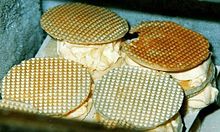 Traditional Iranian ice cream often contains flakes of frozen clotted cream and is most commonly naturally flavoured with saffron and rose water. It is usually served sandwiched between two thin crispy waffles
Traditional Iranian ice cream often contains flakes of frozen clotted cream and is most commonly naturally flavoured with saffron and rose water. It is usually served sandwiched between two thin crispy waffles
The traditional drink accompanying Iranian dishes is doogh, a combination of yogurt, still or carbonated water, and dried mint. Other drinks include sherbets known as Sharbat and Khak shir. One favorite is Aab-e Havij, alternately called havij bastani, carrot juice made into an ice cream float and garnished with cinnamon, nutmeg or other spices. There are also drinks that are not served with meals. These include Sheer Moz (banana milk shake), Aab Talebi (cantaloupe juice), and Aab Hendevaneh (watermelon juice). These are commonly made in stands or kiosks in streets on summer days and on hiking trails. Aab Anaar (pomegranate juice) is also popular and has recently (2007) become popular in North America. Sekanjebin is a thick syrup made from vinegar, mint and sugar, served mixed with carbonated or plain water. It can be drunk mixed with a little rosewater or used as a dip for Romaine lettuce.
Dessert dishes range from Bastani-e Za'farāni (Persian ice cream, also called Bastani-e Akbar-Mashti or Gol-o Bolbol) to faludeh (a frozen sorbet made with thin starch noodles and rosewater). Persian ice cream is flavored with saffron, rosewater, and includes chunks of heavy cream. There are also many types of sweets, divided into two categories: Shirini Tar (lit. moist sweets) and Shirini Khoshk (lit. dry sweets). The first category consists of French-inspired pastries with heavy whole milk whipped cream, glazed fruit toppings, tarts, custard-filled éclairs, and a variety of cakes. Some have an Iranian twist, such as the addition of saffron, pistachios, and walnuts. The second category consists of more traditional Iranian sweets: Shirini-e Berenji (a type of rice cookie), Shirini-e Nokhodchi (clover-shaped chickpea flour cookies), Kolouche (a large cookie usually with a walnut or fig filling), Shirini-e Keshmeshi (raisin and saffron cookies), Shirini-e Yazdi (small cakes originating from the city of Yazd), Nan-e kulukhi (a kind of large thick cookie without any filling), and others.
Other popular sweets include Zulbia, Bamieh and Gush-e Fil. Bamieh is an oval-shaped piece of sweet dough, deep-fried, and then covered with a syrup traditionally made with honey. Bamieh is similar to tulumba, but much smaller, 2 or 3 centimeters wide at most. Zulbia is made of the same sort of batter, also deep-fried, but poured into the oil in swirls, then covered with the same syrup (or with honey).[5] Zulbia have been popular in other parts of the world at least since early medieval times, with recipes in the 9th century CE Arabic cookbook of Ibn Sayyar al-Warraq; they are now known as Jalebi in India and Pakistan, and Zulabiya in North Africa. Goosh-e Fil (lit. elephant's ear) is also made of deep-fried dough, in the shape of a flat elephant's ear, and then covered with powdered sugar. One of the classics, Halvardeh (Tehrani for halvā-arde, from halvā, an Arabic loan word meaning 'sweet', plus arde, the Persian word for tāhini). Halvā comes in various qualities and varieties, from mainly sugar to sesame seed paste (the aforementioned Persian arde), and pistachios.
Noghl, sugar-coated almonds, are often served at Iranian weddings.
Essential accompaniments
There are certain accompaniments (mokhalafat) which are essential to every Iranian lunch (nahar) and dinner (shaam), regardless of the region. These include a plate of fresh herbs, called sabzi (basil, cilantro, fenugreek greens, tarragon, Persian watercress or shaahi), a variety of flat breads, called naan or noon (sangak, lavash, barbari), fresh white cheese (panir, somewhat similar to feta), sliced and peeled cucumbers, sliced tomatoes and onions, yoghurt, and lemon juice. Persian gherkins (khiyarshur) and pickles (Torshi) are also considered essential in most regions.
Tea (chai) is served at breakfast. It may be served at other times, based on the region, usually many times throughout the day. For example, in the province of Khorasan it is served immediately before and after lunch and dinner. The traditional methods of tea preparation and drinking differ between regions and peoples.
Regional cuisine
Region Food Translation Province Southern Iran Ghovatou Kerman Ghaliye Mahi "Fish Casserole" Bushehr and Khuzestan and Hormozgan Koloocheh and Masgati "brittle biscuit" and "Rose water confection" Shiraz Central Iran Angosht-pich Hamadān Pashmak Cotton candy Yazd Baghlavaa Qottab Morasah-Polo Tehran Iranian Kurdistan Kaak Kermanshah Naan-berenji Khoresht-e Khalal Sibb-polo Yekaveh Kurdistan Gheimeh Tarreh Ash-e Shalami Bourany Iranian Azerbaijan Ahari East Azerbaijan Sabzi-qovurma Qurabiya Ris Baglava Rahatol holgum West Azerbaijan Noghul Girdakan Halvasi Northern Iran
Kateh is the traditional dish of Gilan and Mazandaran, and is simply Persian rice cooked in water, butter and salt until the water is fully absorbed. This method results in rice that is clumped together and is the predominant style of cooking rice in the Caspian region. In Gilan and Mazandaran, kateh is also eaten as a breakfast meal, either heated with milk and jam, or cold with Persian cheese (panir) and garlic. Kateh is commonly eaten in other parts of Iran because of its short cooking time and easy preparation, and is prescribed widely as a natural remedy for those who are sick with the common cold or flu, and also for those suffering from stomach pains and ulcers.
Iranian caviar and Caspian fish roes hails from that region, and is served with eggs, in frittatas (kuku sabzi) or omelettes.
Gilan and Mazandaran is probably home to the most numerous list of recipes compared to other regions. Some Gilani and Mazandarani dishes are:
- Alu Mosema
- Anar Bij
- Ash-e Fatima Zahra (In respect and honor of her)
- Ash-e Shalqam
- Ash-e Shir
- Ash-e Qalamkar
- Ash-e Torsh
- Badenjan Torshi (pickled eggplants)
- Baqala bij
- Baqala Qatoq
- Choqortmeh
- Dalar (a Meze)
- Felfel Torshi (pickled piments)
- Fereni
- Fesenjan
- Haftabijar
- Halvaye Raqayeb
- Kabab torsh
- Kateh
- Khali Ash
- Khalou Abeh
- Kolucheh Fuman
- Kolucheh Lahijan
- kuku Eshpel
- Kuku gerdu
- Longi
- Mahi Dudi
- Mahi Fibij
- Mast o Khiar (a Meze)
- Mirza Qasemi
- Morabaye Badrang
- Morabaye Bahar Narenj(Orange flower jam)
- Morabaye Gol Mohammadi
- Morabaye Kadu
- Morabaye Shaqayeq
- Morabaye Velesh
- Morabaye Zoqal Akhteh
- Morq-e Torsh
- Naz Khatun
- Piyaz Torshi (pickled onions)
- Reshteh Khoshkar
- Rob e Narenj
- Rob e Anar
- Rob e Sir Torsh
- Shah Kuku
- Shami-e Rashti (Rashti Shami Kebab)
- Sheshandaz
- Shirin Tareh
- Shur Mahi
- Sirabij
- Sir Qaliyeh
- Sir Torshi (pickled garlic)
- Spinach thick soup (Ash-e Esfenadj)
- Torshi Kebab
- Torsh Shami (Sour Shami Kebab )
- Torsh Tareh
- Vavishka
- Yaralmasi Torshi
- Zeytun Parvardeh (a Meze)
 Reshteh Khoshkar with its origin in Gilan, is a notable syrup-soaked pastry of ground walnuts & cinnamon.
Reshteh Khoshkar with its origin in Gilan, is a notable syrup-soaked pastry of ground walnuts & cinnamon.
The Gilani variety of rice is considered one of the best in Iran, where it has been in use since the fourth century BCE.
Eating fresh raw Mazandarani broad beans is common in Gilan and Mazanderan, either alone or with cooled Kateh, salted fish eggs (Ashpel ); but selling and enjoying (especially by people of the lower classes) of hot cooked broad beans (bāqelā-garmak) sprinkled with salt and powdered Persian marjoram (golpar) are not an uncommon street scene in cold weather almost everywhere in Iran. The Gilani dish Baqali Qatoq is cooked with dill garlic, and turmeric, into which eggs are emptied at the end.[6]
Khuzestan
Main article: Khuzestan#People and CultureEsfahan
Esfahan in Central Iran is home to Persian foods including:
Status Dish English name Description well known and/or culturally significant Fesenjan a casserole type dish with a sweet and tart sauce containing the two base ingredients, pomegranate puree and ground walnut cooked with either chicken, duck, lamb or beef and served with rice. Gaz the name given to Persian Nougat using the sap collected from angebin, a plant from the Tamarisk family found only on the outskirts of Esfahan. It is mixed with various ingredients including rose water, pistachio and almond kernels and saffron. Sohan-e-Asali Honey Toffee A toffee made from honey and butter flavoured with cardamom and saffron and coated with slivered almond and pistachio kernels. Khoresht-e-mast Yoghurt Stew is a traditional dish in Esfahan. Unlike other stews despite its name it is not served as a main dish and with rice; since it is more of a sweet pudding it is usually served as a side dish or dessert. The dish is made with yogurt, lamb/mutton or chicken, saffron, sugar and orange peels. Iranians either put the orange peels in water for one week or longer or boil them for few minutes so the orange peels become sweet and ready for use. People in Iran make a lot of delicate dishes and jam with hull of fruits. This dish often accompanies celebrations and weddings. Notable Berian/Beryoon-Biryani This dish is made of mutton or lamb which is ground/minced and then cooked on one side in a special small pan over open fire. Berian is generally eaten with a certain type of bread, known as "nan-e-tafttoon". Azerbaijan
- Ghormeh sabzi (Herb Stew) and Gheimeh (Split-pea Stew) are traditional stews of Azerbaijan.
- Ghabli
- This traditional dish in Azerbaijan is made of rice, lentil, meat, potato and groats.
- "the torn abdomen" in Azeri
- A kind of Kofteh that unusually large.
- Tabriz is notable for its delicious cookies in Iran, some of which are
- Ghorabiye
- Eris
- Nogha ( نوقا in Persian and Azeri) :That's a special kind of Gaz made mainly in the Azeri regions of Iran. Nogha is almost exclusively made with walnuts instead of pistachios and almonds which are usual for other types of Gaz. The making of Nogha is very much the same as any other Gaz. The difference is that Nogha is usually spread between two very thin layers of wafers and cut into 10x5x5cm sections which are larger than ordinary Gaz cubes.
- Aash (Thick Soup) is popular food in Azerbaijan.The word Aash had passed from Persian into the Central Asian Turkic languages.[1] Varieties of Aash (Thick Soup) in Azerbaijan include:
Aashs Aash Translation Kahskh Aash Dried Whey Thick Soup Turshulu Aash Sour Thick Soup Yogurtlu Aash Yogurt Thick Soup Isfanaj Aashi Spinach Thick Soup Aash Mast Yogurt-soup (in Ardabil) Traditional table settings
The traditional Iranian table setting firstly involves the tablecloth, called sofreh, and is spread out over a Persian rug or table. Main dishes are concentrated in the center, surrounded by smaller dishes containing appetizers, condiments, side dishes, as well as bread, all of which are nearest to the diners. These latter dishes are called mokhalafat (accompaniments). When the food has been served, an invitation is made to all those seated at the sofreh to help themselves.
Structure of meals
Breakfast
Breakfast is called sobhaaneh (Persian: صبحانه) or nāshtāyi (Persian: ناشتايى). The basic traditional Iranian breakfast consists of a variety of flat breads (naan-e sangak, naan-e lavaash, and others), butter, Tabrizi white cheese (paneer), feta cheese, whipped heavy cream (Sarshir, often sweetened), and a variety of fruit jams and spreads. Other popular traditional breakfasts (which require far more preparation) include haleem (wheatmeal served plain or more commonly with shredded lamb or turkey - similar to Western oatmeal in some respects), aasheh mohshaalaah (thick soup). These latter breakfasts are typically regional specialities, and many cities and towns all across Iran feature their own distinct versions of these dishes. Both aasheh mohshaalaah and haleem are typically prepared the night before, to be served the next morning, and haleem is usually only served at certain times of the year (haleem specialty restaurants are only open during those times), except in southern parts of Iran, where haleem is always present. Kaleh paacheh(lit. sheep's entire head and its hooves) is almost always only served from three in the morning until sometime after dawn, and specialty restaurants (serving only kaleh paacheh) are only open during those hours.
Lunch and dinner
Lunch and dinner (naahaar or shaam) are not distinguished in Persian. Traditional Persian cooking is done in stages, at times needing hours of preparation and attention. The outcome is a well-balanced mixture of herbs, meat, beans, dairy products, and vegetables. Major staples of Iranian food that are usually eaten with every meal include rice, various herbs (mint, basil, dill, parsley), cheese (feta or Persian panir, derived from goat or sheep's milk, and sometimes cow's milk), a variety of flat breads, and some type of meat (usually poultry, beef, lamb, or fish). Stew over rice is by far the most popular dish, and the constitution of these vary by region. Tea (chai) is the drink of choice on nearly every occasion, and is usually served with dried fruit, pastries, or sweets.
You can usually find tea brewing throughout the day in most Iranian homes. Doogh, a yogurt drink, is also quite popular. One of the oldest recipes, which can trace its existence back to the time of Persian empire, is khoresht-e-fesenjan, consisting of duck or sometimes chicken in a rich pomegranate-and-walnut sauce that yields a distinctive brown color, most often served with white rice.
Fast food, imported and adapted foods
Popular fast food items in Iran include Chelow kabab (literally "rice and kabaab"), joojeh kabab (the same, but substituting grilled or broiled chicken), naan o kabaab (literally "bread with kabab"), kabab sandwiches, and a number of different derivatives of traditional slow-cooked meals. An increasing preference for American style food amongst a younger generation of Iranians has resulted in the establishment of many pizza, steak, hamburger, and fried chicken establishments, but Western food is sometimes served alongside staples such as those mentioned above, and is often prepared differently (most notably with pizza). Chinese and Japanese cuisine has also become popular in recent years, primarily in Tehran, and Italian and Mediterranean restaurants are also featured. The noted influence of European and American culture before the Islamic Revolution has also imparted preparations such as bechamel, gigots, milanesas and others to Iran.The outstanding characteristic of modern Iranian cookery is its conservatism. The much discussed craze for Western things (Gharb-zadagi) has had little or no effect on the people’s eating habits. In this field, Iranian cultural resistance to Western influences has shown particular strength.[1]
Historical Iranian cookbooks
Although the Arabic cookbooks written under the rule of the Abbasid Caliphate include some recipes with Persian names and clearly derived from Persian cuisine, the earliest classical cookbooks in Persian that have survived are two volumes from the Safavid period. The older one is the Kār-nāmeh dar bāb-e tabbākhī va sanat-e ān ("Manual on cooking and its craft") written in 927/1521 by Ḥājī Moḥammad-ʿAlī Bāvaṛčī Baḡdādī for an aristocratic patron at the end of the reign of Shah Esmail. The book originally contained 26 chapters, listed by the author in his introduction, but chapters 23 through 26 are missing from the surviving manuscript. The recipes include measurements for ingredients; often detailed directions for the preparation of dishes, including the types of utensils and pots to be used; and instructions for decorating and serving them. In general the ingredients and their combinations in various recipes do not differ significantly from those in use today. The large quantities specified, as well as the generous use of such luxury ingredients as saffron, suggest that these dishes were prepared for large aristocratic households, even though in his introduction, the author claimed to have written it "for the benefit of the nobility, as well as the public".
The second surviving Safavid cookbook, Māddat al-ḥayāt, resāla dar ʿelm-e ṭabbākī ("The substance of life, a treatise on the art of cooking"), was written about 76 years after the Kār-nāmeh by Nūr-Allāh, a chef for Shah Abbās. The introduction of that book includes elaborate praise of God, the prophets, the imams, and the shah, as well as a definition of a master chef. It is followed by six chapters on the preparation of various dishes: four on rice dishes, one on qalya, and one on aash. The measurements and directions are not as detailed as in the Kār-nāmeh. The information provided is about dishes prepared at the royal court, including references to a few that had been created or improved by the shahs themselves; other contemporary cooks and their specialties are also mentioned.[7]
Persian cuisine abroad
One of the main reasons that Persian cuisine is not widely recognized is that it is often confused with Middle Eastern cuisine, a much broader and more general term, and this confusion is further perpetuated by restaurants and markets providing authentic Persian cuisine that label themselves as such.
Many Persian super-markets and restaurants are labelled as Middle Eastern, International, or Mediterranean in order to broaden their appeal to the Western consumer. In reality, Persian cuisine is one of the oldest and richest cuisines in the world, and- except for the shared dishes with neighbouring cuisines, during Ottoman contacts- is typically vastly different from what is found in the greater Middle East.
It should be mentioned that Persian cuisine has lots of similarity to Turkish and Greek cuisines in its Kebabs and other dishes due to cultural contacts with Greeks and Turks. Although not widely recognised, Persian cuisine is gaining popularity in multicultural cities, especially in London, Los Angeles, Vancouver, Washington, D.C., and Toronto, which have significant Persian populations. Los Angeles and its environs, in particular, are well known for the number and quality of Persian restaurants which are usually centered around Kebab, but almost always also serve various stews as well.
Another reason for the relative obscurity of Persian cuisine is the lack of professional restaurant management. Many Persian restaurants (at least in smaller towns or those with smaller Persian populations) are started by immigrants who have little or no experience in the food and catering business. This lack of experience often means the proprietors focus most of their energies on preparing and providing good quality food but very little on marketing, ambience and service. Many such businesses die in obscurity despite the high quality and authenticity of their food.
Photo gallery
See also
- Agriculture in Iran
- Abgoosht
- Advieh
- Zam Zam Cola
- Culture of Iran
- Ghelyan
- Zereshk
- Kabab Koobideh
- Chelow kabab
- Tursu
- Kabab Barg
- Polow
- Middle Eastern cuisine
- Khoresht
- Samanu
- Tahdig
- Juglans regia (Persian walnut)
- Gondi dumpling
- Tarkhine
- Islamic dietary laws
References
- ^ a b c Fragner, B.. "ĀŠPAZĪ". Encyclopedia Iranica. http://www.iranica.com/articles/spazi-cookery. Retrieved 2009-03-13.
- ^ Ghanoonparvar, M. R.. "Dolma". Encyclopedia Iranica. http://www.iranica.com/articles/dolma. Retrieved 2009-04-05.
- ^ Ramazani, Nesta. "Uses of the Fruit in Cooking". Encyclopedia Iranica. http://www.iranica.com/articles/beh-quince-cydonia#pt3. Retrieved 2008-10-11.
- ^ Ramazani, N.. "ĀB-ḠŪRA". Encyclopedia Iranica. http://www.iranica.com/articles/ab-gura. Retrieved 2011-06-26.
- ^ Some Iranian Pastries with images
- ^ Aʿlam, H. "BĀQELĀ". Encyclopedia Iranica. http://www.iranica.com/articles/baqela-also-pronounced-baqala-or-baqali-in-arabic-texts-baqella-broad-beans-i. Retrieved 2009-04-07.
- ^ Ghanoonparvar, Mohammad R.. "Cookbooks". Encyclopedia Iranica. http://www.iranica.com/articles/cookbooks-classical-in-persian. Retrieved 2009-04-05.
Further reading
- Batmanglij, Najmieh (1992). New Food of Life. Washington, DC: Mage Publishers. ISBN 0934211345.
- Batmanglij, Najmieh (2002). Silk Road Cooking: A Vegetarian Journey. Mage Publishers. ISBN 9780934211635.
- Batmanglij, Najmieh (2006). A Taste of Persia: An Introduction to Persian Cooking. Mage Publishers. ISBN 9781933823133.
- Daniel, Elton L.; Mahdi, Ali Akbar (2006). Culture and Customs of Iran. Greenwood Press. pp. 149–155. ISBN 9780313320538.
- Ghanoonparvar, Mohammad R. (2006). Persian Cuisine: Traditional, Regional, and Modern Foods. Mazda Publishers. ISBN 9781568591919.
- Mazda, Maideh (1960). In a Persian Kitchen. C. Tuttle.
External links
Middle Eastern cuisine Asian cuisine Sovereign
states- Afghanistan
- Armenia
- Azerbaijan
- Bahrain
- Bangladesh
- Bhutan
- Brunei
- Burma (Myanmar)
- Cambodia
- People's Republic of China
- Cyprus
- East Timor (Timor-Leste)
- Egypt
- Georgia
- India
- Indonesia
- Iran
- Iraq
- Israel
- Japan
- Jordan
- Kazakhstan
- North Korea
- South Korea
- Kuwait
- Kyrgyzstan
- Laos
- Lebanon
- Malaysia
- Maldives
- Mongolia
- Nepal
- Oman
- Pakistan
- Philippines
- Qatar
- Russia
- Saudi Arabia
- Singapore
- Sri Lanka
- Syria
- Tajikistan
- Thailand
- Turkey
- Turkmenistan
- United Arab Emirates
- Uzbekistan
- Vietnam
- Yemen
States with limited
recognition- Abkhazia
- Nagorno-Karabakh
- Northern Cyprus
- Palestine
- Republic of China (Taiwan)
- South Ossetia
Dependencies and
other territoriesCategories:
Wikimedia Foundation. 2010.


